
Kylie Ho, Senior Director of Strategy and Tim Collins, VP of Global Supply Chain at Blue Origin join us to discuss the key innovations helping the company make space more accessible for the benefit of humanity.
Stay














Kylie Ho, Senior Director of Strategy and Tim Collins, VP of Global Supply Chain at Blue Origin join us to discuss the key innovations helping the company make space more accessible for the benefit of humanity.
Stay












Welcome to the May edition of INNOVATION Magazine!


We are delighted to share two exclusive interviews with you this month, alongside the latest global technology news and

Innovation Magazine is a specialist technology platform with over 166,700+ readers.
For our cover interview, I welcome the chance to chat with Kylie Ho, Senior Director of Strategy and Tim Collins, VP of Global Supply Chain at Blue Origin. Kylie and Tim elaborate on the innovation and technology behind the company’s vision of tapping into the limitless potential of space for the benefit of people on Earth (
Our community consists of C, V and D level executives from a wide range of industries. A unique blend of thought leadership interviews and features that cover digital transformation, cloud & cyber, enterprise IT, artificial intelligence, machine learning and sustainability.
Brian Singer, Chief Information and Technology Officer at Angels of Care Pediatric Home Health, joins me to discuss the values, digital transformation, and strategies spurring growth and success at the company (p56).



In our global tech features this month, we cover the crucial importance of people in ), transforming sports fans’ experiences with AI ( Banyan Group’s latest sustainability report ( ), marvelling at the latest quantum computer from Fujitsu and RIKEN ( ), celebrating the new employee wellness ) and announcing the latest funding to boost Digital Earth
Last but by no means least, our Startup of the Month is Ori – the UK-based tech company providing end-to-end AI infrastructure (

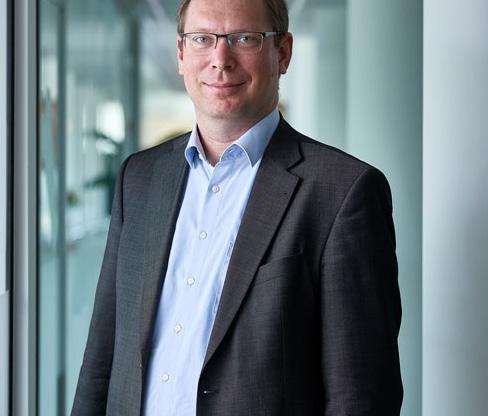

We hope you enjoy our latest edition. As always, if you would like to be considered as an interviewee or if you have a story for us, please do get in touch.
editorial@ithink.media connect with me on LinkedIn.





Kylie Ho and Tim Collins launch into the innovation strategy at Blue Origin

The future of AI is still human-centred, according to Foolproof

Exploring the experiential potential of artificial intelligence in sport
still according
72 Fujitsu and RIKEN unveil groundbreaking quantum computer



Brian Singer on the values and technology driving success at Angels of Care
44 Dive into the insights from the Banyan Group’s 2024 Sustainability Report
80
Learning tech platform Thrive reveals new employee wellbeing programme
104 Meet Ori, our Startup of the Month

New funding for Digital Earth Africa announced
Kylie Ho, Senior Director of Strategy and Tim Collins, VP of Global Supply Chain at Blue Origin join us to discuss the key innovations helping the company make space more accessible for the benefit of Earth.


With rocket technology, mission of access
Watch The New Shepard Astronaut Experience

With its first-of-its-kind reusable rocket engines and innovative launch technology, Blue Origin is on a mission to radically reduce the cost access to space. he company has a longterm vision of greatly increasing the number of people that fly into space, with its sights set on a future where millions of people will be able to live and work in space to benefit the Earth. Its two reusable rockets, New Shepard and New Glenn, have launched 51 people into space so far across 11 human spaceflights.
Joining us from Blue Origin is Kylie Ho, Senior Director of Strategy and Tim Collins, VP of Global Supply Chain, to explore how Blue Origin is leveraging emerging technologies across the organisation to enable
innovation in space and serve its central mission. To begin, Kylie outlines Blue Origin’s vision for the future of the industry.
“Blue Origin was founded by former Amazon CEO Jeff Bezos, with a very particular vision in mind,” says Kylie. “We want to enable a future where millions of people are living and working in space for the benefit of the Earth. Our planet is finite and fragile, but it’s also the perfect home for humanity – so we want to keep it happy and healthy for future generations.
“Meanwhile space is limitless, with a vast expanse of resources that we can
“What we procure and the companies we partner with play a significant part in making space more accessible”
Tim Collins, VP of Global Supply Chain at Blue Origin
harness to benefit life on Earth –for instance, by augmenting our energy consumption.
“We’ve seen energy consumption increase dramatically on Earth. Even if there are significant improvements in our energy usage efficiency, researchers still project that it won’t be enough to meet our growing demands on our planet and its finite resources. To balance this, we can turn to using the resources available in space to protect our planet.
“To make this possible, we first need to dramatically reduce the cost of access to space. If you’re going to leverage space to benefit Earth, you need to have routine, reliable, low cost and safe access to space, and

facilitating that is one of our earliest and most important foci to date.

“Additionally, even if you can offer increased accessibility to space, you still need to effectively leverage space resources, as it’s impossible to bring everything with you from Earth to space. That’s why we’ve been prioritising work around the Moon, as it’s our closest celestial body with resources like water, ice and precious metals. This can help us support activity in space to nurture life on Earth. We often say that we want to build a road to space, and the Moon is a vital stop for supplies along that road.
“It’s important to acknowledge that this is a long-term journey that we’re on. We don’t expect to have millions of people living and
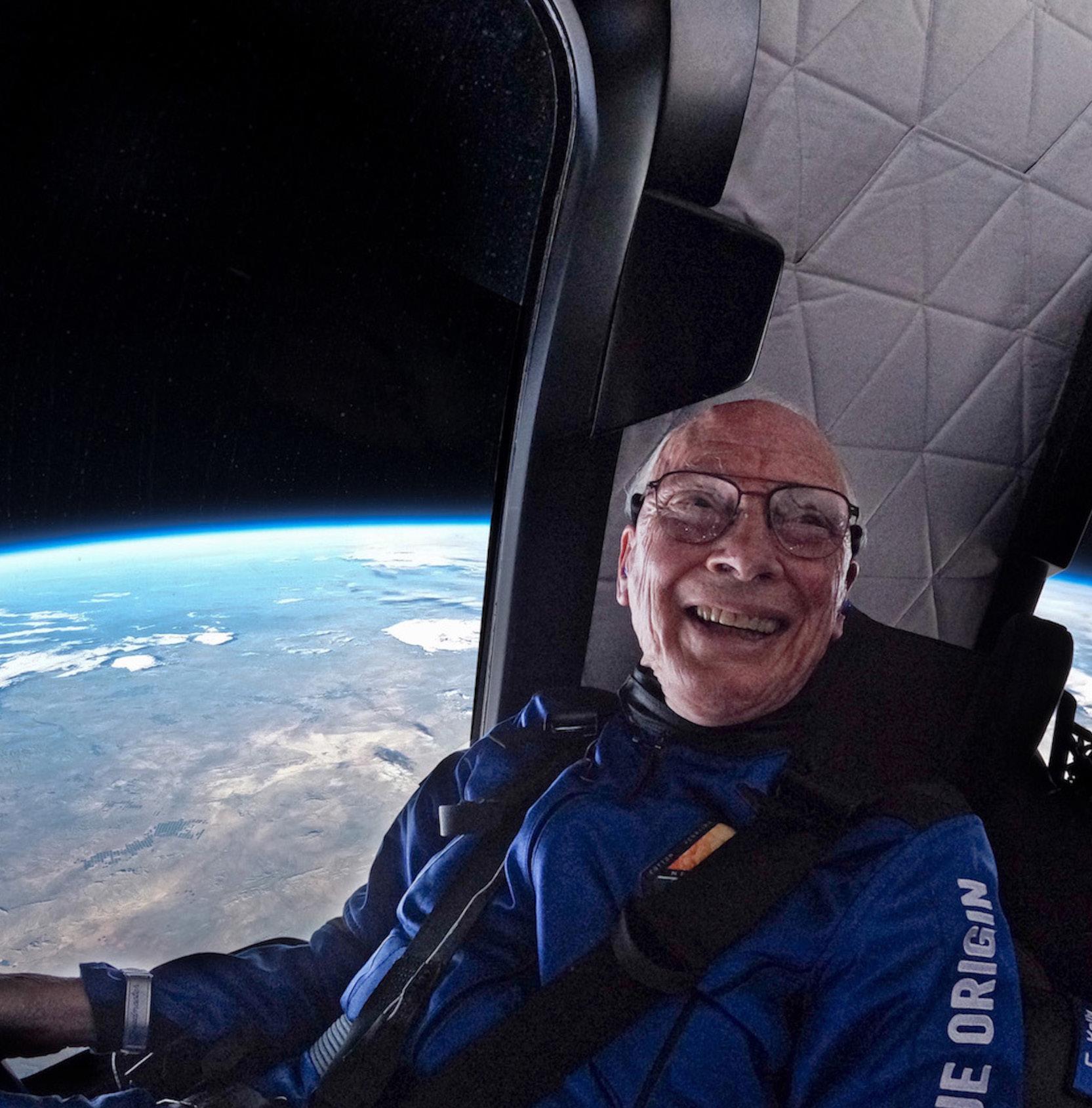
working in space anytime soon, so we need to inspire the next generation to carry this mission forward. Therefore, we do a lot of work from a strategic perspective to ensure that we are educating the next generation about these critical issues and arming them with the skills and education to help to create that future.”
As Tim explains, a key aspect of achieving this mission is Blue Origin’s procurement strategy.
“What we procure and the companies we partner with play a significant part in making space more accessible,” says Tim. “We’re looking for reliable partners to work with, because not only does that provide us with a highquality product but also leads to lower long-term costs – crucial when we’re aiming to offer reduced cost access to space.
“For instance, Precision Fluid Controls has been a phenomenal partner for
us, providing us with a number of different components. They’ve been a supplier who’s really leaned into the innovation and value engineering side of things – they want to work with us to produce products efficiently and creatively. With them, we’ve been able to drive our cycle time down by half, which in turn has helped us significantly drive down costs.
“When you look at the total strategy of what we are doing as an
organisation – through innovative design, materials and partnerships – our supply chain operations are absolutely central to our success.”
Tim also emphasises the work Blue Origin does with MSC as being central to the company’s mission to provide lower-cost access to space.
“MSC is another company that provides us with a number of different components – a lot of our

“We have a series of programmes – starting with our New Shepard suborbital rocket – to help us achieve our mission of increasing access to space”
Kylie Ho, Senior Director of Strategy



In the space industry, even the tiniest part plays a crucial role in driving progress and exploration forward. For more than 35 years, SeyTec has distributed the highest quality hardware, fasteners and supply chain solutions for leading aerospace and defence OEMs.



At SeyTec, we are upward thinking and all about making the impossible possible. Backed by over 560 years of combined aerospace industry experience, our expert team is ready to help you navigate supply chain challenges and open the door to progressive innovations.

Woman-Owned Small Business setting a new standard for diversity in STEM
National Aerospace Standards Committee (NASC) member
Provider of industry-leading fasteners, small electronics, wiring harnesses, custom kits and more
Trusted by Blue Origin and other major OEMs
Key partner in the Artemis Program, contributing to the return to the moon
Innovative and custom-tailored solutions that exceed aerospace industry standards for quality and reliability
Seamless VMI execution rooted in just-in-time delivery principles
End-to-end supply chain optimisation and cost-saving logistics
At SeyTec, we take immense pride in our small part of the global journey into the final frontier by supplying the critical hardware that enables the space sector to lift off. Our solutions are not just built for today, but designed to meet the challenges of tomorrow, ensuring our customers remain at the forefront of space technology. Together, we are not just reaching new heights – we’re redefining them, one part at a time.
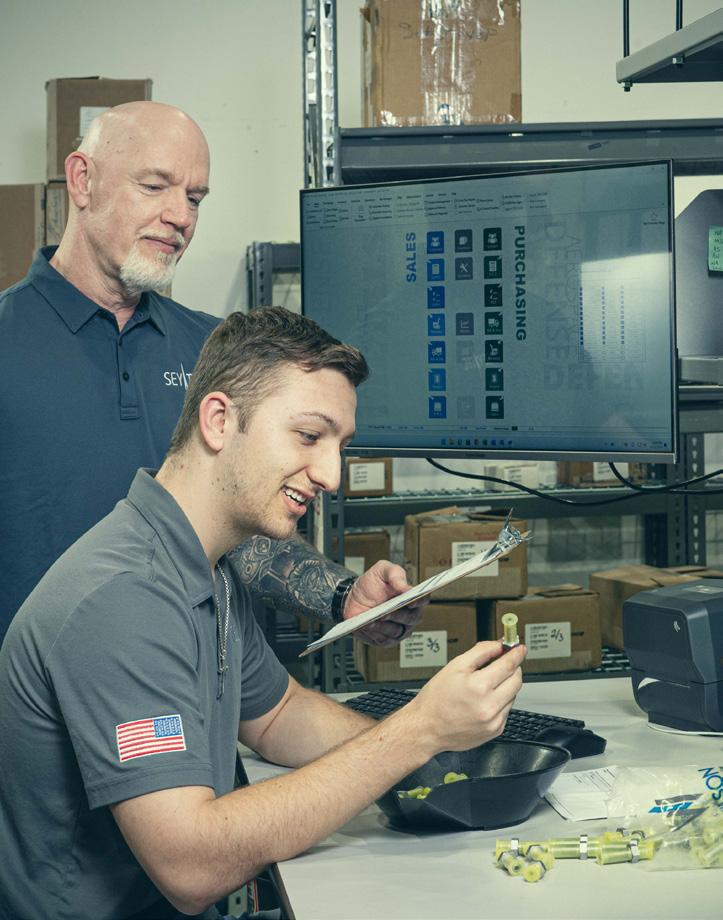

industrial components and materials,” says Tim. “They’ve been incredible. With any engagement we have with them, they’re always finding ways to make things better for us.
“For instance, they’ve found ways to aggregate the procurement of two or three kinds of materials and package it together to save us a lot of money and lead time. They really are partners to us, and they have made a real difference in helping us innovate within the supply chain.”
Having a robust supply chain network is crucial for a company like Blue Origin, particularly at such a significant point in time for the commercial spaceflight industry. Here, Kylie jumps in to explore the programmes and innovations Blue Origin is developing to provide new commercial activities on Earth.
“We have a series of programmes – starting with our New Shepard suborbital rocket – to help us achieve our mission of increasing access to space,” explains Kylie. “Almost 20% of all women who have gone to space have gone on a Blue Origin flight, and we’re looking closely at how we can change the makeup of who has access to space.
“Traditionally, only select governments with enough funding were able to explore space, but we built up our New Shepard programme to open this up to private citizens. These aren’t professional astronauts, so the entire
“We’re building tremendous heritage and expertise into things like liquid propulsion systems, vertical take-off and vertical landing, and feeding forward that knowledge into New Glenn”
Kylie Ho, Senior Director of Strategy
experience was designed to be very safe and very simple. Since launching this programme, we’ve been lucky to have the oldest and the youngest people ever go to space on our rocket.
Ultimately, New Shepard was designed to be our first step in opening up commercial activity in space.
“We’ve since taken a feedforward approach to New Glenn, our larger orbital rocket, which we were able to successfully launch in January of this year – thanks to our prior work on New Shepard. We’re building tremendous heritage and expertise into things like liquid propulsion systems, vertical take-off and vertical landing, and feeding forward that knowledge into New Glenn.”
Blue Origin’s newest rocket, New Glenn is designed to accommodate a
variety of payloads and destinations to meet the broadest range of customer needs – significantly reducing cost per launch.
“As we move forward with New Glenn, we imagine that we will see significant opportunity for the commercial sector,” says Kylie. “For instance, we’ll need commercial satellite operators who provide broadband internet, direct cellular connectivity and data backhaul to support our increasingly connected world. These are all fields that are going to further ignite commercial activity here on Earth.
“Humanity also has the opportunity to unleash our creativity with New Glenn. New Shepard opened up a new regime
of opportunity with commercial private space travel, and New Glenn is going to open up additional opportunities for entrepreneurial activities from our customers and partners.
“This approach will then feed forward into our other systems –things like our Blue Moon Lunar Lander, built to access the lunar surface in partnership with NASA’s Artemis programme. And we’re also getting a lot of interest from commercial customers, who can see the potential of the untapped lunar surface.
“We’re also very excited about further utilising our Blue Ring


platform, which is a highly manoeuvrable spacecraft that can go between the Earth and the Moon, and even to Mars, to help us open up access to space and unleash new creativity as it relates to science and to our commercial customers.
“Every single one of our products are about creating the layer of infrastructure that enables entrepreneurship, new ideas and innovation. We’re excited to engage with customers who want to leverage these new systems and create opportunities that weren’t available ten years ago.
“That’s what makes the space age today so exciting – we’re at the cusp
of real transformation. New Shepard is our first foray into the world of pioneers going to space as private citizens, but orbital access is going to increase significantly over the next several years. What we’re trying to emphasise is how we can best utilise these platforms and the space environment to benefit the Earth.”
These new innovations are making significant progress in the commercial spaceflight industry, and Blue Origin is excited to further this work.
“We were the first company to land a booster vertically in 2015 with New Shepard, but that was years in the making,” says Kylie. “To see that technology through we needed things
“Automation is crucial to our operations, both in our plants and through our wider logistics strategy”
Tim Collins, VP of Global Supply Chain at Blue Origin
like liquid propulsion systems that are throttleable and allow you to reignite and land under a powered engine.
“There’s been a lot of exciting innovations with New Shepard, and we’re taking those innovations with us as we develop our New Glenn rocket. It leverages a version of the New Shepard engine, is powered by the same fuels and is similarly vertically landed to allow us to reuse the rocket.
“As we apply everything we’ve learned to our New Glenn rocket, we’re looking forward to many more launches. In future, we’re hoping to undertake deep space missions to the Moon and Mars, as well as a whole host of opportunities for access to orbit with New Glenn.
“However, we have some other exciting items on our roadmap, like our Blue Moon Lunar Lander. That lunar lander is built to allow us to have a sustained
presence on the lunar surface, so we’re ready to return to the Moon – this time to stay.
“We want to establish a permanent presence there, because it is the closest celestial body with valuable resources we can tap into, it provides amazing learning opportunities to understand how to have long duration crewed missions on a lunar or planetary body and it allows us to explore options for space mobility solutions and habitats.
“All of these things are really beneficial for learning when it relates to the Moon, but the first step is being able to access it routinely, safely and at a sustainable cost.”
But, as Tim explains, this high level of transformation would not be possible without Blue Origin’s commitment to innovating within its supply chain network.
“Supply chain operations never used to be at the forefront of an organisation,” says Tim. “However, with so much innovation taking place, it’s become much more centralised and really is an exciting place to be. For instance, AI is playing a huge role in our global system – we’re weaving it into everything we do, from visibility with our partners to the transfer of documents.

“Automation is crucial to our operations, both in our plants and through our wider logistics strategy. Weaving AI with material handling is
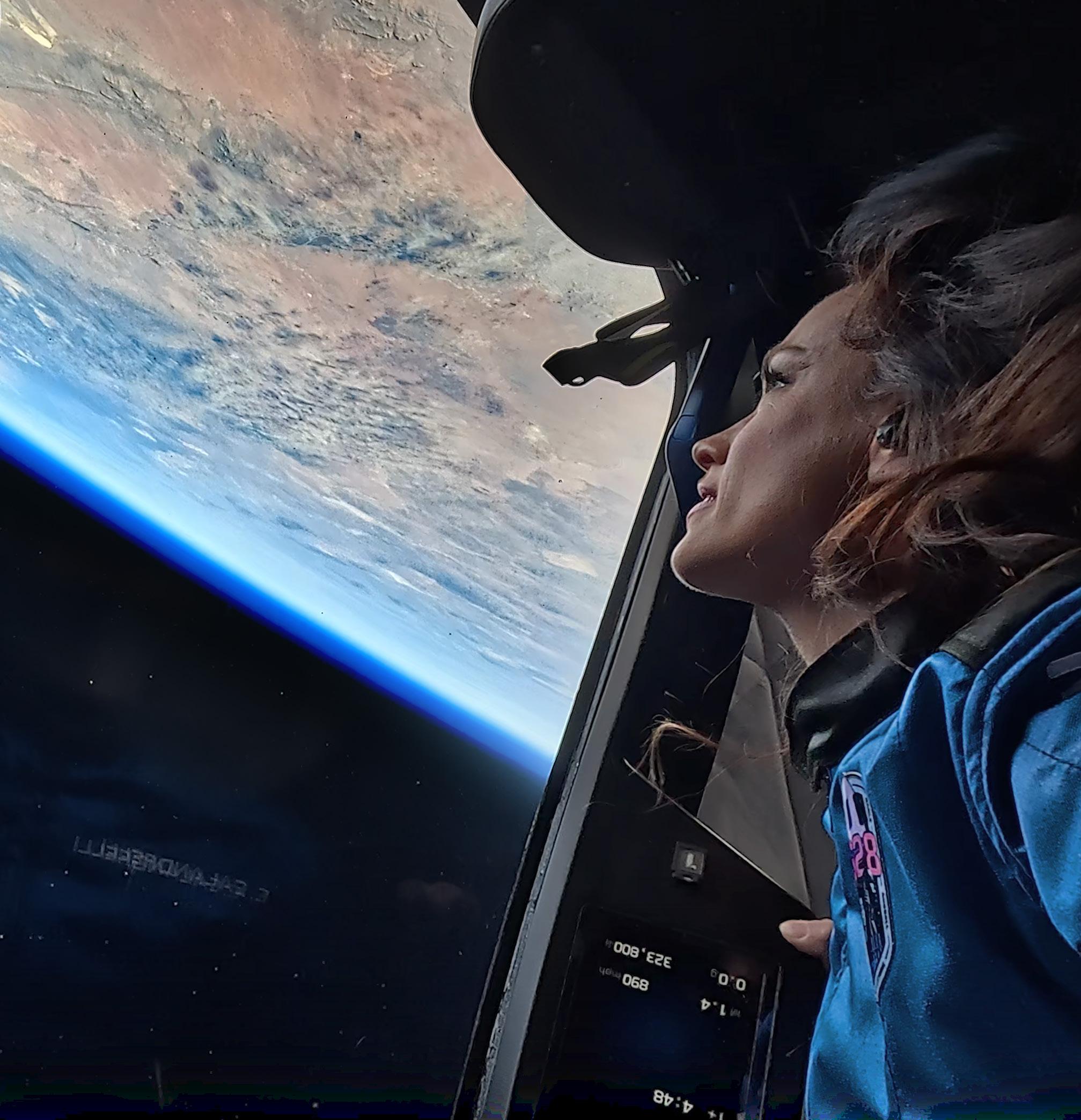
a big strategic driver for us, which makes these processes symbiotic. The software that drives our automation is building on itself to make material handling and manufacturing automation more efficient and run that much smoother.
“It’s an incredibly exciting time to be working in supply chain. I’ve seen
more innovation in supply chain in the last couple of years than the last couple of decades. It’s creating huge opportunities for us to drive our mission forward and significantly lower the cost to get into space.”
Blue Origin’s supply chain operations also play a key role in the company’s sustainability initiatives.
For more than 80 years, businesses like Blue Origin have counted on MSC to provide innovative best-in-class solutions and customised plans to drive productivity, improvements and cost savings in an ever-changing environment.

Trusted Advisor - MSC partners with you to meet your specific goals to drive supply chain optimisation, scalability and standardisation.
Empowering Growth - As a leading industrial distributor, MSC helps you achieve higher productivity through effective and innovative cost savings solutions.
Award-Winning Commitment - Proud recipient of Blue Origin’s 2023 Environmental Award for reducing our carbon footprint.
Preferred MRO Partner - Selected as Blue Origin’s preferred MRO partner to reduce Total Cost of Ownership (TCO). Contact us today. mscdirect.com
“Sustainability is at the core of everything we do,” emphasises Tim. “Ultimately, our mission is to benefit Earth, and our innovation in space will help make the planet much cleaner. On the supply chain side of things, we talk about sustainability every single day.
“With any potential supplier, we engage with them to understand their sustainability practices, and how they innovate within that – whether that’s through their operations, their products or through Value Engineering.
“We also look at everything that we procure, and the raw materials those products come from to ensure
we’re taking as sustainable an approach as possible. By looking at the secondary and tertiary supply chain of every single product we can better understand the efficiency and sustainability of any given part or product.”
With this foundation, the company is turning its focus to new heights –partnering with NASA on its Artemis programme.
“NASA’s Artemis programme, which is this generation’s version of the Apollo era that first brought humanity to the Moon, is all about developing lunar capabilities that are then extended onto Mars,” explains Kylie. “We’re excited to be working with NASA

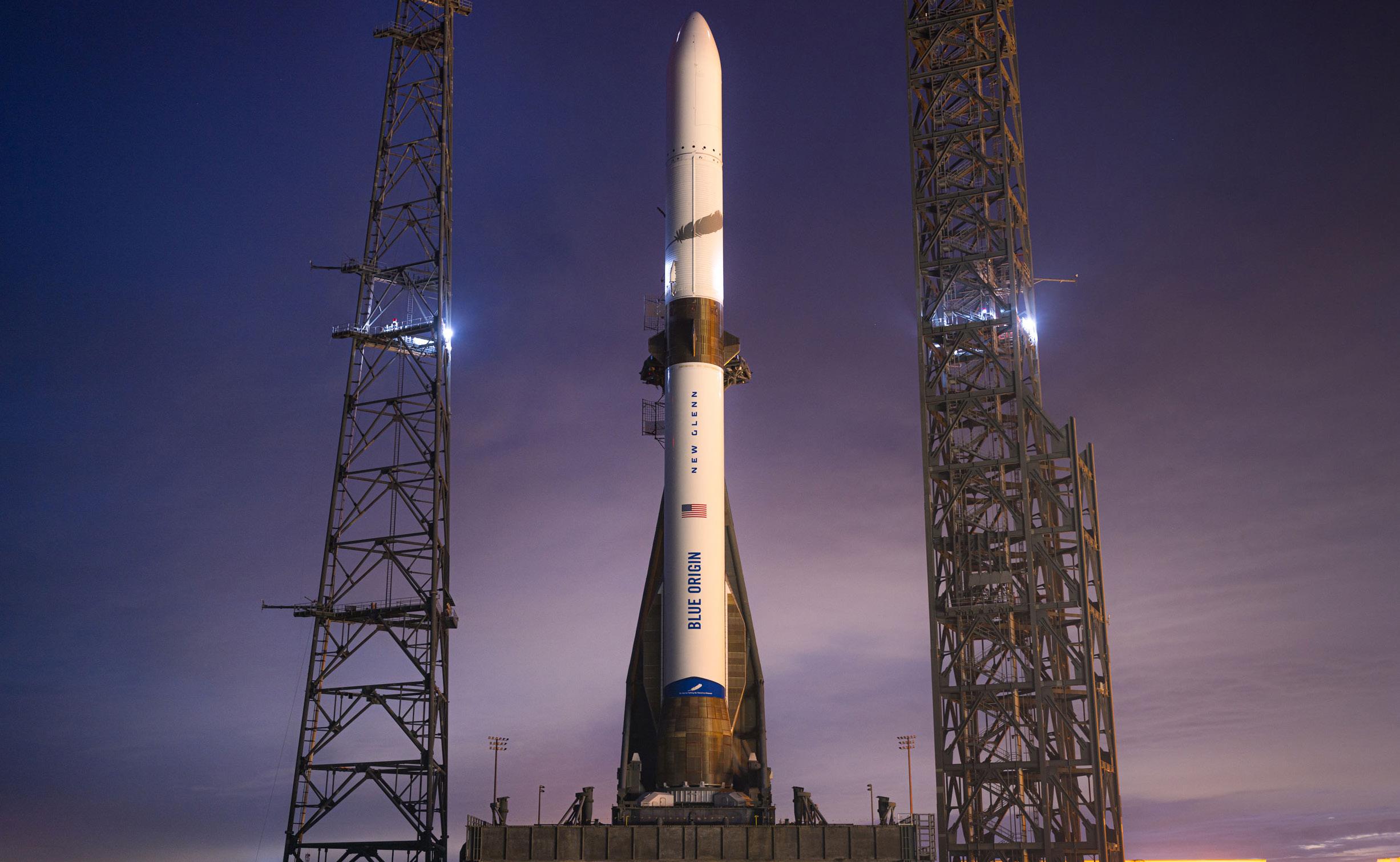
“This is such an exciting time for the industry, and we’re very privileged to be a part of it”
Kylie Ho, Senior Director of Strategy
to support these objectives and help to develop a permanent crew presence on the Moon and Mars.”
Here, Tim weighs in to explain the work Blue Origin is doing with its key suppliers to help them get from the Moon to Mars.
“To get to Mars, we need to do everything we can to build a more efficient, more capable supply chain,” says Tim. “One of the ways we’re doing this is by making sure we effectively engage our suppliers. The work we’re doing is super exciting, and our suppliers love it. When you engage a supplier about making things more efficient then they want to help you, but if you can tell someone that they can help us get to Mars with their products and services then it’s a completely different conversation.”
Two such suppliers Blue Origin is working closely with on this mission are global manufacturer Linde and leading aerospace component distributor Seytec.
“Linde is a long-term partner for us,” says Tim. “They provide a lot of our


Linde is a leader in industrial gases production worldwide. Our liquid hydrogen, liquid oxygen, nitrogen, specialty gases like helium and xenon, and metal powders, boost the limits of space exploration.
The possibilities for the future are endless as space travel and technology continue to advance. Linde is excited and honored to support Blue Origin’s success.
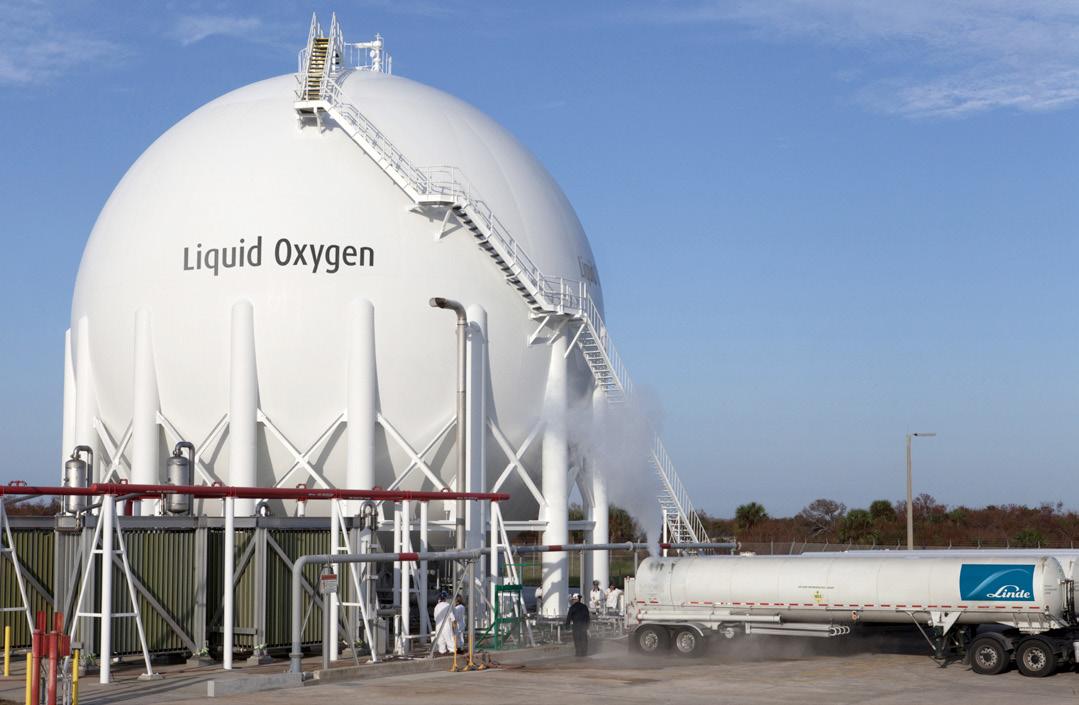
10 Riverview Drive, Danbury, CT 06810
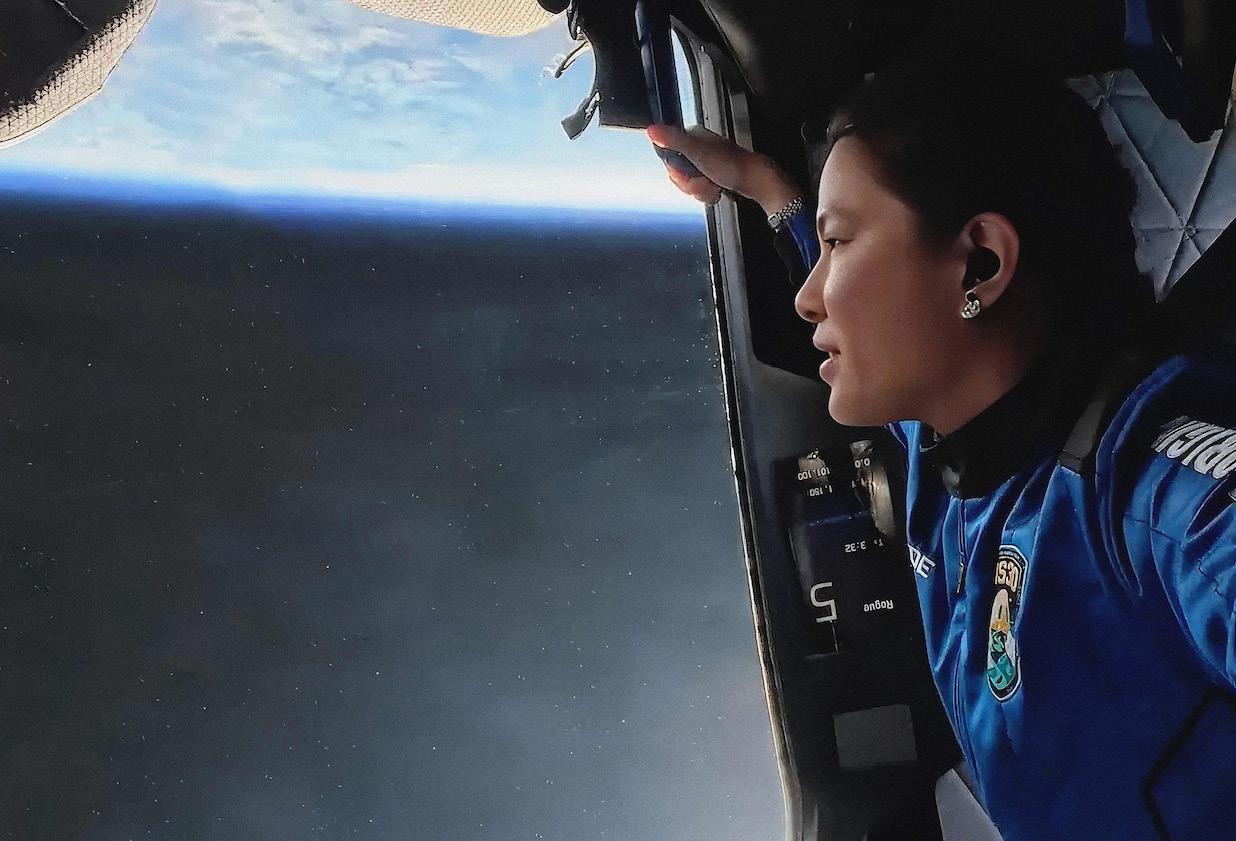
Providing the aerospace industry with bespoke products for over 20 years
Precision Fluid Controls, Inc. (PFC), an AS9100 company, designs, manufactures and tests valves and pressure controls for aerospace propulsion, flight, on-orbit and ground applications.
With a large portfolio of products, we quickly provide solutions for extreme service requirements or create new products based on customer specifications.
Products include main engine valves, vent valves, pressurereducing regulators, check and relief valves, sleeve and butterfly valves – among others.
PFC’s division, Martin Testing Lab (MTL), is an environmental testing lab with extensive test capabilities including vibration, shock, thermal cycling, salt fog, material testing etc.
PFC customers include most commercial launch companies, NASA facilities and launch and test sites.
PFC’s 77,000 sq ft facility is equipped with multiple 4 and 5 axis mills, live tool lathes, several mill/turn centers plus a full quality department with multiple CMMs. PFC has a large clean room for precision cleaning of components and multiple high pressure test cells.





precisionfluidcontrols.com

propellants to our testing and launch operations, and they’ve always been incredible. In this business, things don’t always go exactly as planned, but Linde have been super innovative, reacting really well whenever there’s a disruption or delay.
“If we’re going through a potential launch, Linde knows all the details and is able to think through anything that could go wrong and how we can mitigate that to ensure we’ve got an uninterrupted supply of propellants and fuels. We couldn’t do what we do without Linde.
“Meanwhile Seytec is another great company – they’re a distributor that handles a wide variety of both direct and indirect components for us, and they’ve been incredibly supportive in helping us get things as efficiently as possible.
“Their team is often onsite, at our different operations across the country to concretely understand what it is we do and offer their expertise in making our operations more straightforward.
“It’s a fantastic opportunity, to engage with their team’s ingenuity, experience and ideas. They’re constantly offering better, stronger ways to approach a new initiative, and our partnership with Seytec is a model of the kind of partnership we’re looking for from our suppliers.”
Outside of Blue Origin’s work with NASA, the company is striving to facilitate more opportunities for new players in the space flight industry.
“We’re actively collaborating with international agencies to support their scientific objectives,” says Kylie. “I believe that this will be a key driver for humanity's expansion into space, and we want to make this an international effort.
“Initially only a select few governments could access space, but we now have significantly more space-faring nations – from across Europe to Japan, India, South Korea, the United Arab Emirates and beyond.
“One of the exciting things about reducing the cost of access to space and opening this up is that we’re getting more diversified players who want to be a part of humanity’s role in space. They want to engage in science, they want to engage in international partnerships, and we’re excited to work with them and support their initiatives as it relates to space exploration. This is such an exciting time for the industry, and we’re very privileged to be a part of it.”
Learn more about Blue Origin here.
Turn over for Added Value with Kylie and Tim. How To Book A Flight To Space


“For our company, inspiring the next generation is a strategic imperative,” says Kylie. “We spend a lot of time engaging with the next generation – from elementary school to college students – to create an awareness that what we do here isn’t unattainable. We need people who bring a diversity of skills to build upon the opportunities for innovation and consider the political and legal ramifications of space exploration.
“I spend a lot of my time talking with students to educate them about the opportunities that exist to have a career in space. Of course, we’ll always need rocket scientists, people with a PhD in aerospace engineering. However, people don’t always realise that this industry truly is for everyone, and the people we’re really in need of in this industry are the technicians and builders who want to engage in creating these projects very tangibly on the factory floor.
“It’s so rewarding to educate students that this is a real opportunity that they can pursue, and I’ve spent a lot of time supporting them through Club for the Future, our nonprofit organisation focused on inspiring the next generation. We’ve worked closely with students and teachers to build curriculums that they can engage with to help them understand that space is closer than they may think.”
“As a part of our work with Club for the Future, we’ve been focused on our Postcards to Space initiative,” says Kylie. “It was designed to get a tangible piece of space in the hands of children of all ages, to make it accessible to them.
“With this programme, anyone around the world can take a postcard and write a message for their vision of life in space and send it to us. We then fly it on our New Shepard rocket to the 100-kilometre Kármán Line – the international boundary of space – and then land it back on Earth safely. It’s then stamped as being flown in space and mailed back to you. We’re trying to think of new ways to give people a little bit of space and help them get involved.”
Connect with Kylie


“I’m super fortunate to be a part of this organisation,” says Tim. “We’re learning from some of the most innovative supply chain organisations on the planet, and we couldn’t do what we do here without our phenomenal people.
“Our work is super exciting, and it all comes down to getting the best people on the planet from the best technology and manufacturing companies. The team we’ve been able to build is what I’m most proud of in this role, and having the opportunity to build such a capable supply chain with this team is the best part of my role.”
Connect with Tim


While much of the conversation around artificial intelligence centres on the technology itself, ultimately people deploy AI.
is already transforming how we discover, design, and deliver innovation. It can generate code, simulate user behaviour, and test ideas faster than ever before. Its power is undeniable –but its purpose is still defined by us.
Because while AI can do more, it still doesn’t know why. And without a clear sense of purpose, more isn’t always helpful.
Breakthrough innovation has human meaning and motivation at its core. It starts with asking: Why does this matter? Who is it for? What are we trying to change – and why now? That clarity is – and always will be – a
fundamentally human endeavour.
It’s not just about faster. It’s about better in a way that matters.
To paraphrase Rory Sutherland: “Engineers would spend £6bn to make the Eurostar journey 20 minutes faster – a behavioural economist would suggest hiring supermodels to serve free champagne and make passengers wish the journey took longer.”
Speed is valuable. AI helps us move faster – testing ideas, automating steps, accelerating delivery. But in our rush to ship and scale, we can lose something essential: the space to reflect, to listen, to explore what really matters.

Some of the most important insights in innovation come not from how quickly we can act, but from how deeply we understand. That means carving out time to explore why a problem exists in the first place, what people are really trying to achieve, and what emotional or contextual factors might be shaping their behaviour.
Fast doesn’t always mean shallow – but without intention, it can be. AI can drive velocity, but meaning emerges when we slow down just enough to ask better questions. And it’s often in that pause –in the moment we step back – that we uncover insights that speed alone could never reveal.
The human meaning behind the work
What makes a product resonate isn’t just functionality – it’s the emotional or cultural role it plays in someone’s life. Innovation that lasts is grounded in what people care about, not just what they do.
AI can surface patterns and predict behaviours, but it doesn’t understand meaning in the way humans do. It can tell you what people are doing, but not why it matters to them.
The real challenge is connecting the dots between people’s stated needs, unspoken desires, and the values they
live by. That’s not something AI can intuit. That’s where human insight still leads.
Mistakes, intuition, and the messy, unpredictable path to progress
Innovation is rarely linear. It’s often uncertain, awkward and filled with false starts. But it’s in the progress made working through the complexity where the breakthroughs emerge.
AI can simulate outcomes, run experiments and test endlessly. But it doesn’t get inspired. It doesn’t feel tension or make intuitive leaps. It doesn’t stumble into brilliance by accident.
Some of the most meaningful innovations happen when something goes “wrong” and forces a new perspective. The unexpected insight. The gut feeling that contradicts the data. These are the moments where human intuition – and our ability to adapt – becomes irreplaceable.
More tech doesn’t guarantee more progress
Many organisations are pouring time and resources into AI, hoping for instant transformation. But the presence of new tools doesn’t guarantee meaningful change.
Real progress comes from making better choices – not just more efficient ones. It comes from aligning the tools we use with the outcomes we care about. And outcomes are only meaningful when they reflect human needs, not just business KPIs.
You can build smarter systems, but unless they reflect a deep understanding of why they exist, they risk becoming beautifully optimised distractions.
Not everything should be optimised
Efficiency has its place – but it’s not the same as impact.
“AI can surface patterns and predict behaviours, but it doesn’t understand meaning in the way humans do. It can tell you what people are doing, but not why it matters to them”

Standardisation, automation and personalisation have made digital experiences more consistent. But they’ve also made many of them indistinguishable. The drive to optimise can flatten emotion, reduce nuance and strip away the personality that connects people to products.
Not everything needs to be frictionless. Sometimes, the most memorable, trusted, and loved experiences are the ones that pause, surprise, or challenge us. The ones that speak to values, not just behaviour.
The process of learning matters as much as the solution
We tend to celebrate outputs – what got shipped, how fast, how scalable. But often, the real value lies in how we got there. In the choices we made, the assumptions we questioned, the people we listened to.
AI can accelerate delivery. But it can’t replace the deeper work of learning – about people, about context, and about why the work matters. If we allow automation to replace reflection, we risk solving faster without ever solving better.
The models haven’t caught up to the machines
We’ve been here before. The internet was powerful long before we had the infrastructure to unlock its true
value. We’re in a similar moment with AI. The tools are maturing. But the organisational, ethical and cultural models to use them wisely are still taking shape.
Without human leadership – without someone asking, ‘What are we trying to achieve, and why?’ – AI will optimise toward whatever goal it’s given, whether or not it’s the right one.
So what now?
AI will continue to evolve. It will push us to rethink how we build, scale and deliver. But its impact depends on how we choose to use it.
We still set the intention. We define success. We decide which problems are worth solving, and what values to build around.
That’s why the future of innovation must remain human-centred. AI may be the engine, but humans still chart the course. Without meaning, purpose, and values as our navigation system, speed just gets us lost faster – sometimes in places we can’t come back from.
Want to keep innovation grounded in what matters most?
See how Foolproof, a Zensar company, helps organisations in a world of accelerating technology.
Source: Foolproof
Providing in-game insights, powering highlight making, artificial intelligence (AI) is transforming board, according

highlight reels and supporting decisiontransforming sport for audiences across the according to GlobalData. ahead

While AI has permeated almost every industry, the current deployment of AI in sport could be described as tentative.
hat happens on the field tends not to be affected by technology as much as it potentially could, with adoption generally being slower due to factors such as financial constraints, governing bodies seeking to preserve traditions and the emphasis on human performance remaining the central focus.
However, according to Conrad Wiacek, Head of Sport Analysis at GlobalData, one area that technology, and particularly AI, is starting to have a real impact on is fan engagement.
“With long-form content being the norm for sports broadcasters, the

rise in popularity of short-form videos presents a potential challenge,” Conrad explains. “AI is already being deployed to retain audience interest for longer and improve fan experiences and is only expected to increase in influence going forward.”
“One area we’re already starting to see technology support fan engagement is in real-time statistics, providing insight to audiences far beyond what they can see and record on their own,” continues Conrad.
“With the advanced data processing and analysis capacity of AI, there is a wealth of data that can be leveraged to go beyond traditional statistics.

“For example, AI can power positional and formation analysis, examining events such as player movements, shot selection and accuracy. In combination with AI graphics tools, fans can be provided exciting and unprecedented insight, in-game, in a manner that is easily decipherable. Where AI comes into its own here is its speed in processing vast quantities of data, with fans usually having to wait for a longer break in play for such
insight. Now, shorter breaks within the gameplay can be utilised, keeping more casual fans just as engaged with meaningful insights.
“AI is also already being implemented to monitor for in-game rule violations, particularly within sports like football – though with varying degrees of success across goal-line technology and the introduction of the Video Assistant Referee (VAR). Elsewhere in

“With a litany of prospects competing for their viewers’ attention, the utilisation of AI to retain this attention and improve fan experience will only become more prevalent”
Conrad Wiacek, Head of Sport Analysis at GlobalData


tennis and cricket, Hawkeye technology has successfully reduced human error, and increased response time with absolute certainty, all while keeping the viewers in the loop. On the other hand, VAR remains highly contentious, not always achieving its goal of reducing refereeing errors and creating lengthy pauses in games.
“Quick to respond, the next stage in this process is already in implementation in the form of automated offside detection, which will also rely on AI technology, accelerating decisions where historically the game has been slowed down by the use of the VAR. The data capture, processing and display power of AI will significantly accelerate rule violation outcomes, allowing the game to flow more smoothly and ultimately improving the fan experience.”
“Broadcasting options are also significantly expanded through AI. Using tailored AI models, broadcasters can capture the game using automated camera angles, providing a slicker, 360-degree feel for fans, immersing them in the action,” elaborates Conrad.


“Accessibility is also vastly improved through AI, with tools such as Watson creating highlight reels for the BBC during Wimbledon, the production and distribution of shortform content across social media has never been easier. Utilising highlights is a fantastic way to tap into the shortform content market and capture fans that may be less interested in the longer format.
“For the global market that sport has successfully garnered, AI can also enhance broadcasting through real-time translations and generation of autocaptions, a solution that is much more cost effective for broadcasters than providing multilingual commentary.”
“When systems are functional and heavily relied upon, innovation will always face strong resistance, with sports federations likely to prioritise profits and reinforce the status quo over technology stack upgrades,” summarises Conrad. “However, with a litany of prospects competing for their viewers’ attention, the utilisation of AI to retain this attention and improve fan experience will only become more prevalent.”
Source: GlobalData


The Banyan Group, a global leader in sustainable hospitality, celebrates its green successes in latest findings.
Banyan Group, a leader in sustainable hospitality, unveils its 2024 Sustainability Report
he 19th edition reports on the Group’s advancements in driving action and impact across key environmental, social, and economic dimensions, reaffirming sustainability as a core foundation of its business.
Guided by its founding mission of ‘Embracing the Environment, Empowering People’ and the belief that travel can be a force for good, the Group's key progress in 2024 include:
Accelerating decarbonisation and energy transition:
In line with its ongoing commitment to addressing the business' environmental impact, Banyan Group continued to invest

in energy-efficient infrastructure and on-site renewable energy. Upgrades in lighting systems, air conditioning and room control units, as well as the installation of solar panels and timer controls across properties, resulted in a 5.7% reduction in emissions intensity per occupied room over 2023.
Increasing waste management initiatives:
Through an increased adoption of waste reduction, recycling and repurposing activities – including food donations, composting of kitchen waste and upcycling efforts – 28% of total waste produced was diverted from landfill, a fivepoint increase from the previous year.

Upholding responsible water stewardship:
As a result of the Group's approach to water conservation – focused on infrastructure repairs, proactive leak detection, enhanced storage capacity, and water reuse – water efficiency per occupied room improved by 5.1% compared to 2023.

Championing marine conservation:
Restorations and research projects play an important role in the way Banyan Group seeks to reduce the environmental impact of its operations – the expansion of Our Marine Lab in the Maldives alongside the launch of the Coral Reef Restoration Project in
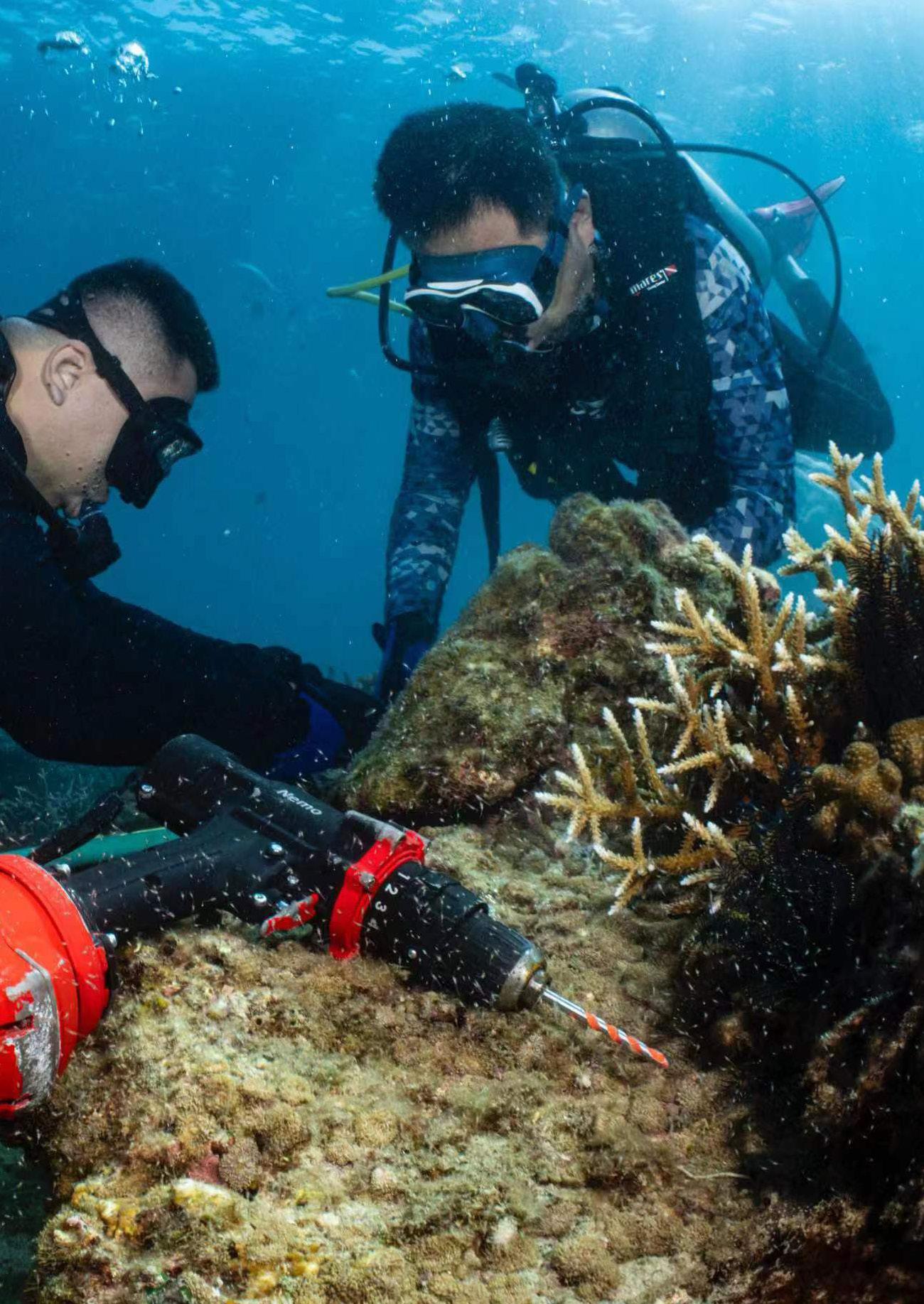


partnership with the China Environmental Protection Foundation (CEPF) in 2024 reinforced its commitment to such conservation efforts.
Deepening support for local communities:
The Group maintained its commitment to uplifting local communities and fostering long-term resilience through education, engagement, and employment opportunities – its signature Seedlings programme nurtured 93 young individuals through training and mentorship, and provided 2,515 internship opportunities. In a continued effort to support heritage traditions and promote rural production to strengthen local economies, the Group expanded its artisan network – commissioning products that supported 306 artisan communities, including 66 newly engaged groups.
Driving change with Greater Good Grants:
To commemorate Banyan Group’s 30th anniversary in 2024, the Banyan Global Foundation funded 30 associate-initiated projects addressing the key material topics identified by the Group. The projects were selected based on criteria including the long-term social, environmental, welfare, and/or financial benefits to the communities where the Group’s
“As we track our progress further refine our associates' meaningfully support responsible practices across
Ho Ren Yung, Deputy Chief Executive
hotels and resorts operate. For more information on the projects, visit: Greater Good Grants.
“Sustainability is a cornerstone of Banyan Group’s purpose, and our journey will continue to evolve as we look to scale increasingly impactful practices in the upcoming years – with more ambitious climate action, deeper community engagement, and greater support for our associates

progress in 2025, we will associates' roles to more support the integration of across our operations”
Executive Officer, Banyan Group

to take action,” said Ho Ren Yung, Deputy Chief Executive Officer, Banyan Group.
“To achieve this, we have introduced key performance metrics aligned with our identified material issues for all senior level associates in front-line and corporate roles, empowering them to champion our ambitions. As we track our progress in 2025, we will further refine our associates' roles
to more meaningfully support the integration of responsible practices across our operations,” she added.
To learn more about Banyan Group's approach, actions, and journey in addressing material sustainability impacts, visit: Our Mission.
To read the full report, visit: 2024 Sustainability Report.
Source: Banyan Group








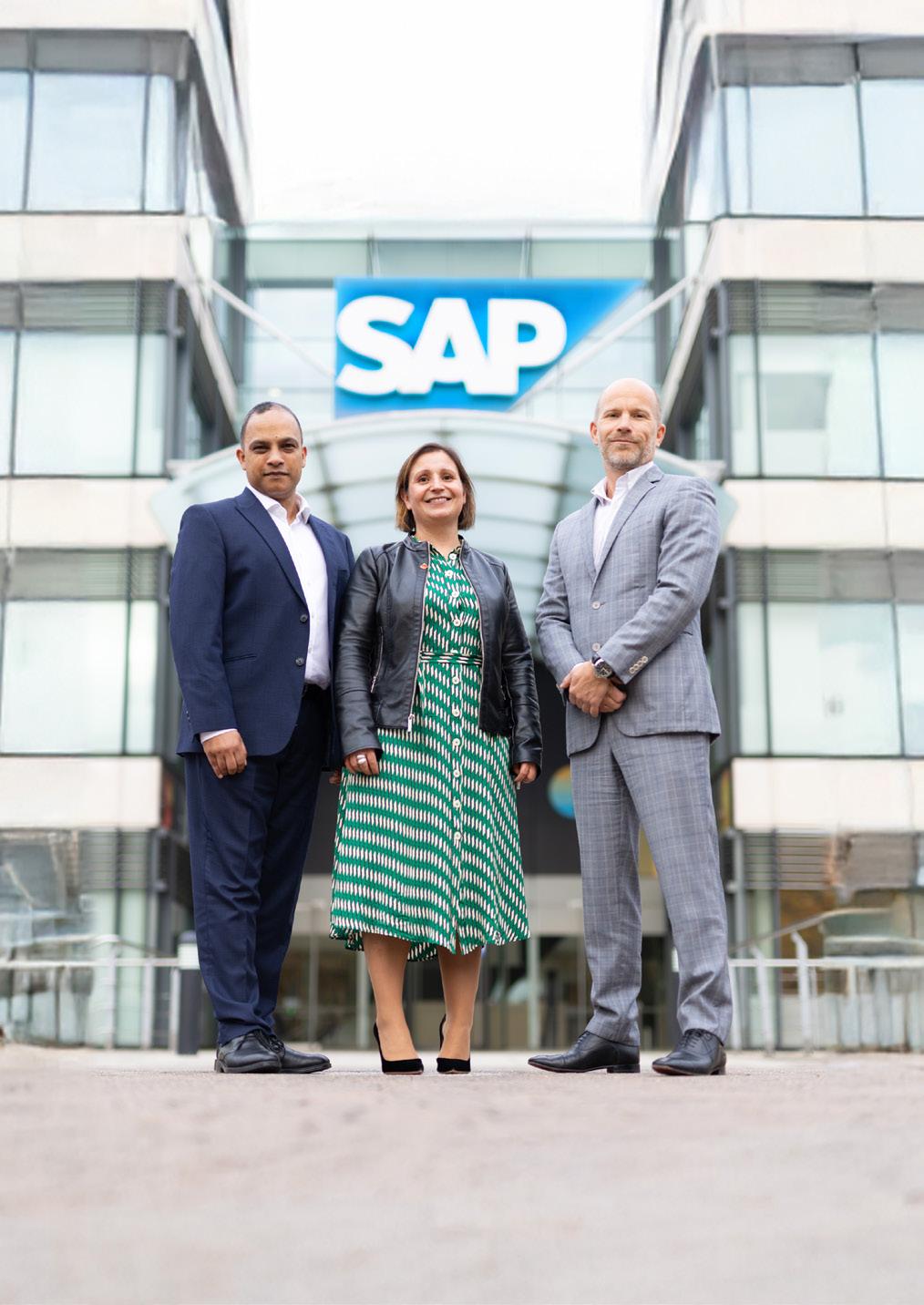





"The team were professional and diligent throughout"
Leigh Feaviour, CTIO for BT’s Supply Chain
"Absolute pleasure working with the Digital Innovation team"
Mun Valiji, Chief Information Security Officer at Sainsbury’s
"A highly professional approach"
Andy Brierley, Vice President, Cloud Application Modernisation at IBM
"Digital innovation Magazine is a very flexible and professional team"
Kim Larsen CTIO, T-Mobile Netherlands





Brian Singer, Chief Information and Technology Officer at Angels of Care Pediatric Home Health delves into the technology, values and strategy behind the company’s industry-leading home healthcare service provision.
ANGELS OF CARE PEDIATRIC HOME HEALTH (ANGELS OF CARE) IS A NURSE-OWNED AND OPERATED PEDIATRIC AND YOUNG ADULT HOME HEALTH AGENCY THAT PROVIDES CHILDREN WITH COMPLEX MEDICAL NEEDS EXPERT INHOME NURSING CARE, OCCUPATIONAL THERAPY, SPEECH THERAPY, PHYSICAL THERAPY, AND MUCH MORE IN A
COMPASSIONATE AND PROFESSIONAL MANNER.
ounded in 2000 by Bonnie West, a pediatric nurse with years of experience working with children with complex medical needs in pediatric home health care, Bonnie had a vision for how pediatric nursing and respite care should be.
Recognising a growing need for support for families with medically fragile children in the North Texas area, she founded Angels of Care Pediatric Home Health (Angels of Care). Bonnie’s mission was to ensure that each child received the same compassionate care she would have provided as a nurse, and that every nurse felt respected and valued, making every client and staff member feel like part of a family.
The company quickly grew as families and caregivers spread the word about the exceptional care provided. This growth led to the opening of numerous branches across Texas, and by 2006, Angels of Care expanded its services to include physical, occupational, and speech therapies. Notably, the company became the first agency in the nation to integrate respiratory therapists into its team, providing comprehensive care that set them apart from similar organisations.
Bonnie’s daughter, Jessica Riggs, has helped lead the company since inception and has been the CEO since 2013. As CEO, Jessica has worked to continue her mother’s legacy while

improving upon care being provided to clients through her innovative approach focused on clinical excellence and improved client and clinician experience.
Here to elaborate on digital transformation crucial to the growth trajectory at Angels of Care is Brian Singer, Chief Information and Technology Officer.
Launching our conversation, Brian dives into the role of digital transformation in helping Angels of Care advocate for its patients by
reflecting on the company’s origins and its journey since then.
“At Angels of Care, we’re celebrating our 25th anniversary this year and I've had the pleasure of working here over the past 18 months,” begins Brian. “As with any startup, we launched with the most basic of processes. You’re going to be dependent on the limited technology you have at your fingertips. When you think about starting 25 years ago in a healthcare space, as a family- and nurse-owned business, up until about 10 years ago,
Jessica Riggs Chief Executive Officer

managing all that by paper wasn't uncommon.
“In 2013, Bonnie decided to step down, and her daughter Jessica took over the reins as CEO. Jessica is an incredible interpreter of needs, and she’s very quick to be able to associate simple ways to reduce complex problems. She’s an absolute problem solver at her core. And while she's not a ‘technologist,’ she is super focused on leveraging technology for solutions.
“Since then, we have embraced our digital transformation journey, becoming highly involved in robotic process automation (RPA) and agentic AI to solve some of our manual processes that are highly prone to human error.
“Also, and again to rewind 10 years, much of the business was managed through chats, emails, and Excel spreadsheets – with colleagues sometimes having to duplicate effort and follow hundreds of steps or workflows. We identified that there was a better way of doing this.
“It was here our digital transformation journey started out, with the very beginning of the process: how we recruit.
“So at the core of our business, we get referrals. For us, a referral is basically a child who needs care, and where we begin is to consider all the details of that child, such as where they need specialised help. But at the same time, there are several core considerations: their location, time frames, rates, insurance companies, you name it. There’s a range of different factors at play.
“But at a basic level, we wanted to make sure that we could do better from a geolocation perspective as a crucial starting point for our digital transformation journey. For instance, if we received a referral for a child in Dallas, we wanted to ensure that we’re recruiting nurses within a 20mile radius to reduce drive time and reach the child as quickly as possible.
“We asked how we could best plot that consideration before we embarked further into the care plan. And we knew there was a better way to do it.
“So 10 years ago, how we started this digital transformation, and ultimately the building of our proprietary workflow system, was to collaborate with tech partners to help us simply generate a map with geolocation capacity – to help our recruiters make this a little bit more streamlined, targeted and simpler.
“Instead of having this broad state-level blast radius in terms of recruiting, we wanted to make it at least closer based on the number and location of nurses that we had in our database.
“That’s how our digital transformation journey started, and we began to see, almost immediately, the efficiencies that we could gain. This early step
expedited our recruiting and candidate placement process tenfold.
“From there, we said ‘Wait a second, if we could do this by simply creating a map, what other inefficient processes could we address?’ So began a process of exploring technology and software to drive more automation or workflow-driven processes. We moved away from instant messaging, texts, emails – and towards a workflow-driven system.
“We called this environment the ‘Angels of Care Operating System’ (AOCOS), sometimes simply referring to it as ‘The Operating System’ because that's exactly what we built. Today almost every aspect of our
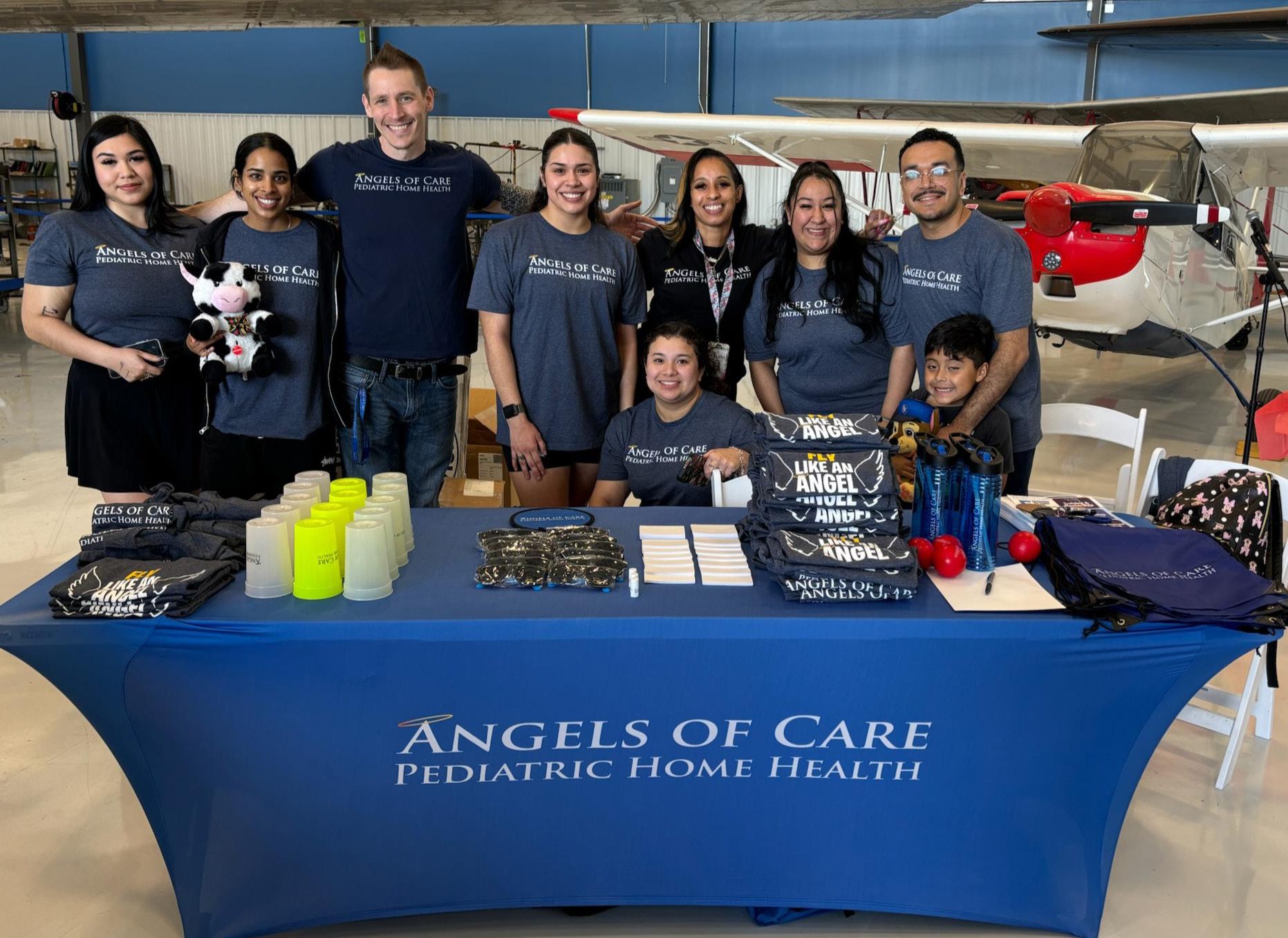
“OUR CONTINUOUS IMPROVEMENT MINDSET IS ALWAYS PRESENT, WE’RE CONSTANTLY PUTTING OURSELVES OUT THERE IN THIS REGARD”
Brian Singer, Chief Information and Technology Officer at Angels of Care
business has at least a small module incorporated into our proprietary platform, which has been built specifically for our use cases.”
Brian lauds the AOCOS as a major driver for Angels of Care’s success, setting the company apart from other organisations in the space.
“When we've compared ourselves to other pediatric home health care companies, it’s abundantly clear this, plus our culture-led processes, have been our secret sauce,” says Brian. “It’s how we've been able to differentiate ourselves, and it really comes down to we use that system to make sure that we look at all of the needs of that child.
“Then we compare that to nurses we have in our database and the specialities they have, and we match that up with the child to make sure that when we hire or when we present a candidate nurse or specialist to the family, we’re sure they’re going to accept them.
“Now, there are other ancillary factors, of course, like rapport and things like that, but from a competency, skill set and location perspective, we are
positive that we are going to be able to place the right nurse, with the right family, with the right skills right from that first step, and that's all simply because of the digital transformation that began 10 years ago with Jessica’s vision.”
Brian adds that the AOCOS has not only been a key differentiator from competitors, but it has also been fundamental to Angels of Care’s national expansion and growth as a leading home healthcare provider.
“We’ve literally taken AOCOS and made it the forefront of our back office management,” says Brian. “Angels of Care now operates across seven states and we’re looking to expand even further. Each one of those states has many branches. Texas is our largest, but we have about 55 branch offices in total right now – so think of those as hubs, and then our children as the spokes radiating out from them.
“The AOCOS serves as the central dashboard for our office team members. When they log in, they’ll see numerous calls to action, with timings set to flag priorities in red, yellow or
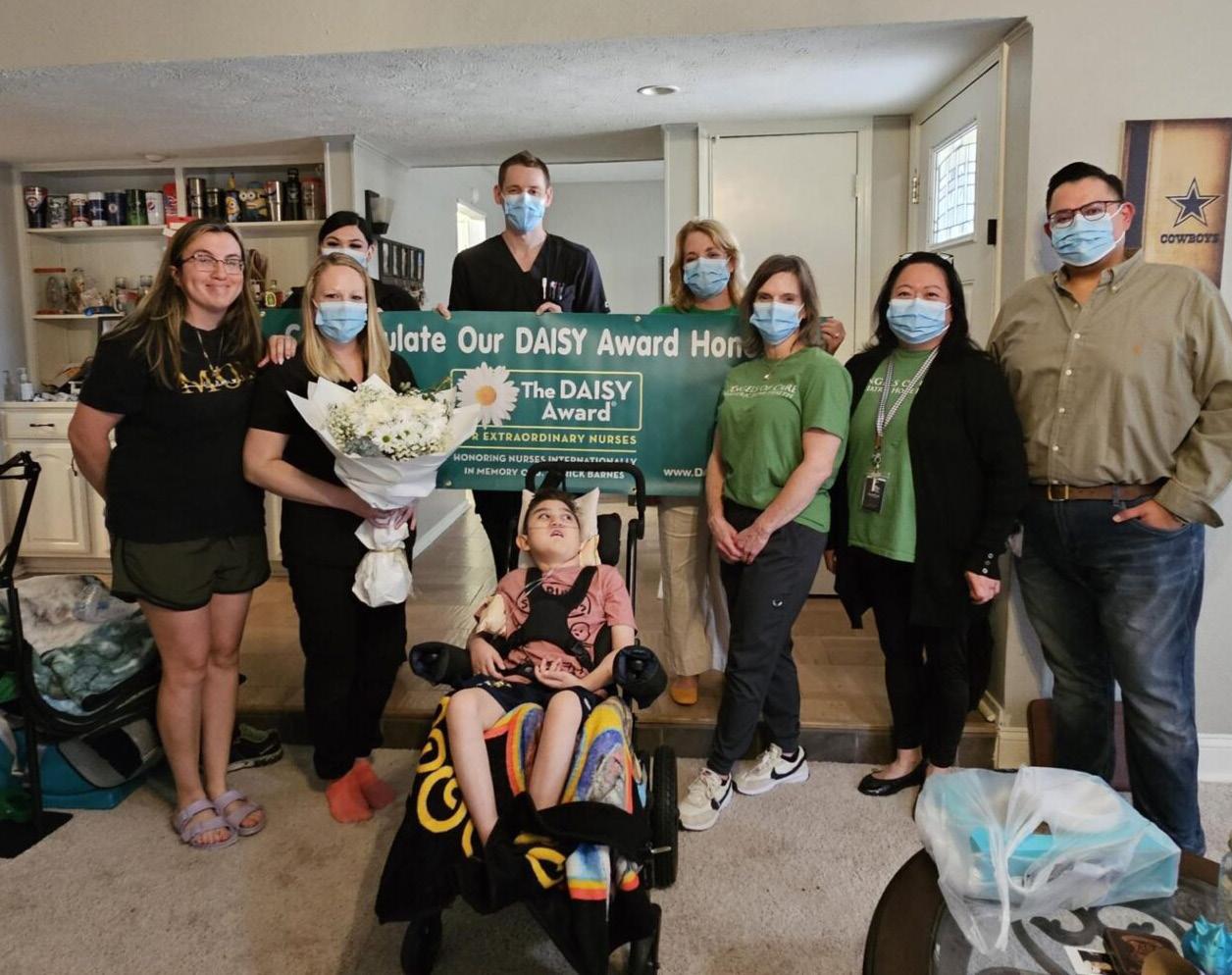
green. We manage authorisations, candidate placements, and referrals to ensure we're not leaving a child behind. But we’re also making sure that we’re not leaving a candidate or clinician behind who wants to be placed to help care for a child. Ultimately, we’re using AOCOS to reduce the gap in closure for care, ultimately, with the child being our first priority.”
In order to fully understand the digital transformation journey at Angels of Care, Brian insists the innovations must be contextualised within the overarching company values.
“Our mission and core competency is called HALOS, and it’s really how we run
our organisation,” emphasises Brian. “I've worked with a lot of companies, big and small. But Angels of Care is the first place I’ve ever worked for that runs so wholly on its mission, which truly starts from the child and works backwards.
“HALOS stands for Heart, Advocacy, Love, Outreach and Speed.
“‘Heart’ comes first because providing the best possible care is paramount and our clients are the heart of everything we do. In terms of ‘Advocacy,’ we want to champion for both our clinicians and our children who need that care. ‘Love’ represents how family and community are

incredibly important to who we are and how that relates to the children and clinicians under our care. We love our employees, and we go above and beyond for them. ‘Outreach’ is about the communities we serve, but also going above and beyond in these places. And then ‘Speed’ is all about how we can improve and move faster, to close the gaps in care, or to close the needs of our children and to make sure that they are always taken care of.
“We enshrine HALOS in all we do through an amazing feedback loop. Engaging with our patients and their families, plus our team members, is incredibly important to us – this allows us to improve continuously,
tapping into these rich insights for opportunities to enhance our technology, software, operations, or approaches.
“For instance, last month, I had an opportunity to attend family visits, and it was an overwhelmingly positive experience. I got so much out of the visits in terms of seeing what we do for the children, witnessing how these families take in the clinicians and make them a part of their family, and understanding how important it is for technologies, response times and communication to be on point.
“At the end of the day, the goal is to always put that child first and to
make sure that everything they need to be successful is presented to them.”
As Angels of Care has grown in the past 25 years, from a startup to an industryleading care provider, Brian explains how this success would not have been possible without collaboration, and strategic partners who shared the company’s vision and appreciated the HALOS mission behind it.
“Before joining Angels of Care, we had partnered with a few contracting organisations to help with IT components of the company,” explains Brian. “First and foremost, Angels of Care is a healthcare organisation, not a technology company, so care trumped
IT as a priority. Understandably, as the company grew, it turned towards partners for support on the IT side of things.
“Nevertheless, just like any company, technology is a component of success, and you still have to have some structure and governance around it.
“So prior to my joining, at the beginning of 2024, a private equity firm had partnered with Angels of Care to provide that type of seniorlevel IT leadership, to assist with that dynamic and implement specific technologies to help us with security and compliance.
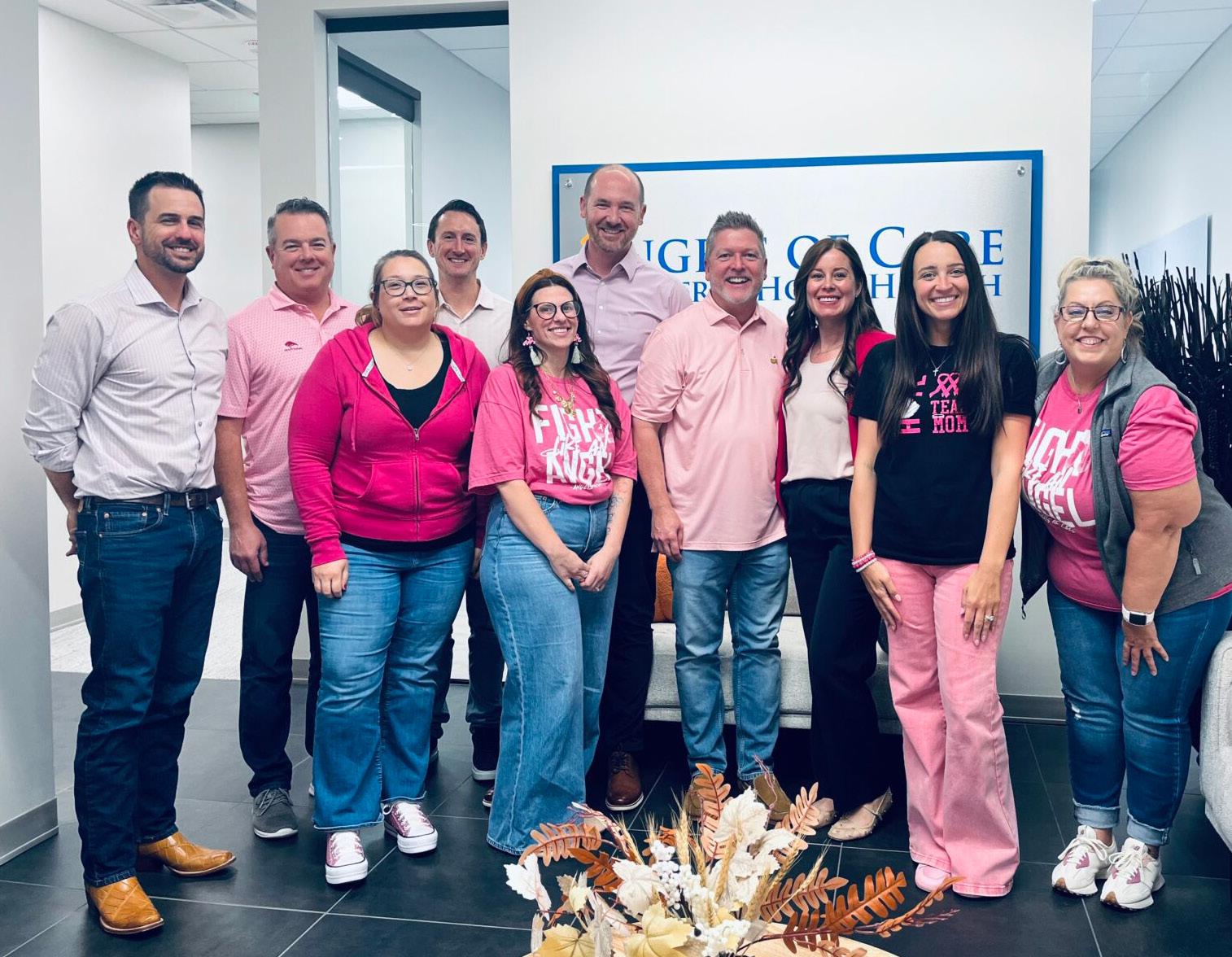
“WE WERE THRILLED TO FIND THE IDEAL PARTNER IN VC3. THE DIFFERENTIATOR IN ULTIMATELY CHOOSING VC3 AS A KEY STRATEGIC PARTNER WAS THAT THEY SPENT SO MUCH TIME GETTING TO KNOW WHAT ANGELS OF CARE WAS ABOUT, FAMILIARISING THEMSELVES WITH OUR TEAM MEMBERS, VALUES AND MISSION”
Brian Singer, Chief Information and Technology Officer at Angels
of Care
“As Angels of Care was looking to level up the technology component of the business the opportunity for me to join the team was presented to me. Through my conversations with Angels of Care, I was energised by talking with Jessica. I've advised in the home care space, while not pediatrics, but I know I have a good understanding of the industry. I've been in healthcare for the better part of the last 15 years, and I also have big tech experience, so I have that balance.
“I began leveraging my private equity partner contacts, to seek Managed Service Providers (MSPs) and Managed Security Service Providers (MSSPs) that could help us with our goals to improve our technology posture; one from an IT, operations, systems and networking perspective, but then also from a security and compliance perspective.
“Once we began to establish a rapport, the collaborative question
of ‘How do we do this together?’ rose to the fore. How could we balance affordability with improving our systems and processes nurturing true external partnerships, but also educating and developing some of the internal management staff?
“Long story short, it became critical for Angels of Care to end up partnering with an organisation that wanted to dedicate time to not just work directly with me, but to work with our senior leaders as well.
“We were thrilled to find the ideal partner in VC3. The differentiator in ultimately choosing VC3 as a key strategic partner was that they spent so much time getting to know what Angels of Care was about, familiarising themselves with our team members, values and mission. In addition, they literally pushed me aside – in the most wellintentioned manner – and worked directly with some of my leaders to help them make recommendations as to why this would be an excellent
Home healthcare never stops. Neither should your systems.
You’ve got medical professionals on the road, teams spread across cities and patient data that must stay protected. Your tablets, laptops, and other devices need to work, and your applications and patient care data must be available. Because when they’re not, care suffers.
That’s why growing healthcare organisations turn to VC3.
We help home healthcare providers keep their systems running, staff supported and patient data locked down. We handle:
• Reliable infrastructure that supports large, distributed teams
• Backups that restore quickly when every minute counts
• Cybersecurity that protects patient data and meets HIPAA or PIPEDA requirements
• Support that’s there when you need it 24/7/365
We’ve spent over 30 years making IT personal, making IT easy, and getting IT right for healthcare organisations. Experience the scalable, secure and collaborative systems you need – all while staying within budget.




partnership, elaborate on which of their offerings would be most beneficial in both the near term and long term.
“VC3 wasn't the cheapest prospective partner we engaged with, but they were the ones that really stretched themselves to say ‘Hey, we believe in what you do, but we also want to partner with you.’ VC3 made it clear they didn’t want to be this ancillary, outside resource. They genuinely wanted to help Angels of Care, and its
senior leaders grow. And they’ve enthusiastically upheld that promise.
“We’re approaching the first anniversary of working together with VC3 so we’re mature in our partnered processes. In that time, we’ve done a wholesale revamp of all of our technologies and software products. We’re advancing all of our compliance, updating policies and procedures along the way. Last but by no means least, they've also been
lending time to my team so that they’re learning as well. These interactions go beyond calls or demos – they’re hosting interactive workshops or Q&As which are far more useful and impactful. VC3 truly is a great partner to Angels of Care in the most holistic sense of the word.”
Looking ahead, Brian is excited for the future at Angels of Care. With pride in the company’s services as a rallying force, he describes how expansion empowered by digital transformation will help define its growth strategy in the coming years.
“We provide the best pediatric in-home care in the country,” summarises Brian. “We don't just say that – we know it and have the data to back it. Therefore, our goal is to have every child in the US under our care, because we do it best.
“So expansion is always on our mind – whether that’s organic, setting up in new states, securing new licensures, building new offices, or through mergers and acquisitions, which we are aggressive with in terms of looking to consolidate regions or streamline statebased pediatric agencies.
“But the success of our expansion hinges on leveraging technology and digital transformation to continue improving our solutions and services. Whether this comes in the form of new tech or equipment, communication capabilities or development projects – the ultimate goal is to grow and develop so more children and their
families benefit from our best-in-class homecare across the country.
“Some of the avenues we’re exploring rely on identifying a new development partner, something we’ve been working on for some time now.
“Our existing development partner has been absolutely paramount in terms of getting Angels of Care to where we are today. We couldn't have done it without them. But at the same time, just like any growing organisation, certain partners were great to move you from A to B, but getting from B to C needs a new approach.
“So we’re looking at how to advance this initiative, seeking to partner with new development organisations that are going to help us take AOCOS to the next level.
“Other priorities include new technology implementations and better integrations across our electronic medical record (EMR) systems, as well as other possibilities such as RPA processes, agentic AI, expanded mobile offerings and a better master data management strategy for business analytics that can prove to be proactive and informative, as opposed to reactive.
“Other in-home care organisations have a one-to-many approach, so one clinician has several patients. We are many to one – the exact opposite. We sometimes have as many as six
clinicians that are caring for one child, so they are really, truly getting that HALOS attention.
“This necessitates holistic care, which in turn requires UX development. If a team member or clinician has to spend significant time looking at screens or devices, that’s less attention directed towards the child. By developing our UX and tech integration, simplifying
The unifying power of Annual Goals
“One thing that’s great about Angels of Care is we have an Annual Theme to guide us for the year,” shares Brian. “Last year, it was ‘Level Up,’ which manifested as everybody in the company having the opportunity to take a step up and think like their manager or senior leaders.
“This year, it's ‘All In’ which encompasses different meanings for various folks. In my personal case, it coalesced around feeling stretched thin. For instance, budget season is always stressful, but the Annual Theme helped me reframe the situation, reminding myself that we’re ultimately here to put the children first.
“With ‘All In’ front of mind, I felt reenergised about how I could contribute and add value – either by tweaking
and enhancing with efficiency in mind, our staff can spend more time on what matters – focusing on our clients.”
Wrapping up our conversation, Brian reflects on the ever-evolving nature of innovation and digital transformation at Angels of Care.
“Our continuous improvement mindset is always present, we’re
processes, adjusting accountability in certain areas or diverting unnecessary expenses back into the business.”
“I've had the pleasure of learning from a great many mentors in my life, and I’ve also relished the chance to mentor people in return,” says Brian. “My mentors are still a part of who I am today, and as such, I also do that in reverse. There are people that have been a part of my career from years and years ago, that I continue to mentor to this day.”
“I try and stay really close to the local communities I work in,” explains Brian. “I'm involved with a CIO and CTO group here in Dallas, plus some other local groups.
constantly putting ourselves out there in this regard,” concludes Brian. “It's like any technology company that continues to reinvest in itself. We are reinvesting in our confidence to continue to drive other opportunities. There's not a day that goes by where we aren’t trying to figure out ways to improve ourselves, to develop in ways that will make both the patient and family’s lives, plus our clinicians’ lives, better.
“This is super critical to how we are constantly innovating – embracing organic, digital transformation where everybody contributes to better care for the children we serve.”
Learn more at angelsofcare.com.
“Not only does this help me feel connected, but it also benefits the business from a networking perspective by getting our name out there, assisting in recruitment and generally raising awareness of who we are and what we do.
“But more than this, it allows you to share your pain points with your network. When you connect with the community, you realise many people are having the exact same challenges that you are. From here you can problem solve creatively, tapping into the broader wisdom and experience of those around you.”
“Angels of Care does so much for its employees and their families, it’s just so humbling,” celebrates Brian. “We have an annual Employee

Appreciation Day where everybody gets together in the summer, and we give a car away to an employee. Last year we gave away a Volkswagen Atlas, and this year it’s going to be a Ford Mustang. There’s water slides, balloons and activities for everyone. All our employees’ families are invited, and it's just amazing.
“As a company, we also coordinate drives and other fundraising initiatives. For instance, right now there's a t-shirt drive to help support an employee’s family member. I just love this community aspect, and it’s so important for what Angels of Care represents, for who Jessica is, and her mother Bonnie’s legacy.”
Connect with Brian

Fourfold increase in qubits on Fujitsu and RIKEN’s hybrid quantum computing platform to expand computational capabilities.

Fujitsu and Fujitsu Limited and RIKEN recently announced the development of a world-leading superconducting quantum computer, at the RIKEN RQC-FUJITSU Collaboration

announced world-leading 256-qubit computer, established Collaboration Center.
his new quantum computer builds upon the advanced technology of the 64-qubit iteration, launched with the support of the Japanese Ministry of Education, Culture, Sports, Science and Technology in October 2023, and incorporates newly developed high-density implementation techniques.



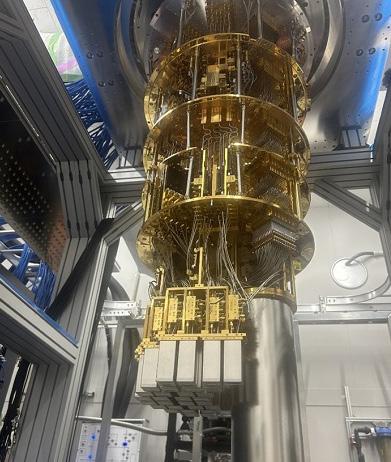
This groundbreaking development marks another crucial step toward the practical application of superconducting quantum computers and unlocking their potential to grapple with some of the world’s most complex issues.
Both organisations will integrate the 256-qubit superconducting quantum computer into its platform for hybrid quantum computing lineup and offer it to companies and research institutions globally starting in the first quarter of fiscal 2025.
The platform’s expansion from 64 to 256 qubits empowers users to tackle more complex challenges, including the analysis of larger molecules and the implementation and demonstration of sophisticated error correction algorithms.
Moving forward, both organisations will further enhance the platform’s usability by working to enable seamless collaboration between quantum and classical computers, enabling the efficient execution of hybrid quantum-classical algorithms.
Fujitsu and RIKEN's 256-qubit superconducting quantum computer overcomes some key technical challenges, including appropriate
cooling within the dilution refrigerator which is achieved through the incorporation of high-density implementation and cutting-edge thermal design.
Fujitsu is committed to accelerating the practical application of quantum computers from both hardware and software perspectives. Through its platform for hybrid quantum computing, Fujitsu will provide larger-

scale quantum computers to global companies and research institutions conducting joint research in various fields, including finance and drug discovery.
Fujitsu and RIKEN will continue R&D efforts toward the launch of a 1,000-qubit computer, which is scheduled to be installed in a new building at Fujitsu Technology Park in 2026.
In addition, the two organisations will extend the installation period of their Collaboration Center from March 2025 to March 2029, and will continue to work on the longterm R&D of technologies that will enable the realisation of even larger superconducting quantum computers.
Source: Fujitsu Limited

Following the success of its four-day work week medical trial, Thrive’s “Wellness Era” programme will incentivise employees to exercise and sleep.

Thrive, the fast-growth all-in-one learning recently announced the launch of its “Wellness employee wellbeing initiative designed to reward investing time in themselves and building new

“Wellness Era,” a bold new reward employees for new healthy habits.

he company anticipates a significant return on investment through increased productivity, enhanced goal attainment, a surge in innovation, and a more balanced and fulfilling work-life experience for its employees.
Known for its innovative approaches to staff engagement, Thrive continues to experiment with new ways to reinvent employee experience, from periodic teambuilding activities to a ban on meetings. The results of its fourday week assessment, which was the first medical trial of its kind in the UK, demonstrated how positive physical and mental wellbeing brings a tangible impact to productivity and business outcomes.
To continue enhancing its workforce and take advantage of the benefits, Thrive is trialling this new initiative as part of a broader wellness drive to prioritise employee health.
Thrive’s “Wellness Era” encompasses a range of programmes and benefits designed to address physical and mental wellbeing.
The company has invested in a partnership with wearable tech

company Whoop to offer employees the opportunity to participate in tracking challenges based around activity, sleep, stress and strain. Participation in this programme is entirely voluntary, and employees have the option to opt-in. Participants can win cash prizes for completing these challenges, rewarding them for investing in new healthy habits and achieving their personal goals.
Simultaneously, the programme flags when individuals encounter issues, such as sleep difficulties, and

“At Thrive, we believe that our employees are our greatest asset, and their wellbeing is directly linked to our success”
Cassie Gasson, Thrive’s Co-CEO


suggests proactive, targeted support options for Thrive, like wellbeing kits or spa vouchers.
“We’re not afraid to try new things,” says Cassie Gasson, Thrive’s CoCEO. “At Thrive, we believe that our employees are our greatest asset, and their wellbeing is directly linked to our success. We also understand that true wellbeing is a continuous journey, not a fleeting trend. That's why we’re committed to cultivating a sustainable culture of wellbeing and we’re constantly looking for innovative ways to improve their lives, both inside and outside of work. Our ‘Wellness Era’ is just the latest experiment in our ongoing quest to create a productive and fulfilling workplace, and we’re incredibly excited about its potential.”
The “Wellness Era” challenges are aligned with themes like Healthy Eating Week and Stress Awareness Month and communicated through internal campaigns and leadership broadcasts. Those who choose to opt-in can participate in monthly challenges (12 in total throughout the year) designed to build healthy habits and earn rewards, such as:
• Snooze for Success: Sleep score challenge, which rewards employees for getting a good night’s sleep.
• Move More Monday: Completion of a 45-minute activity to start the week strong.


• Wellness Walks: Step count challenge throughout the month.
• Pedal Power: Mileage challenge via road, spin or Peleton.
Extending to those who choose not to opt-in to wearable tracking, Thrive’s "Wellness Era" provides various participation options for everyone, including:
• "Sport Back" Programme: Where employees can expense team sports activities like paddle tennis, rock climbing or badminton.
• Family Involvement: Extending the focus on wellbeing beyond the workplace, Thrive encourages family participation in activities like park runs. The family that participates in the most family park runs will win a day out at a theme park or attraction of their choice, paid for by Thrive.
• Health Shield Cashback Plan: Allowing employees to claim back expenses for services like massage therapy.

• Subsidised Race Entries: To encourage participation in running and other fitness events.
• Group Activities: Including a 5k run club every Thursday and group dog walks.
“Thrive is demonstrating that putting employee wellbeing first leads to a more productive, innovative, and successful business. We believe this commitment to wellbeing also fosters a more responsive and
supportive partnership,” says Adam Dobinson, Learning and Development Business Partner at The Bannatyne Group. “As a customer, with Health & Wellbeing at our core, we truly value this long-term approach, knowing that a healthy, engaged Thrive team will continue to deliver an outstanding platform and results for us, aligned to our Business Mission!”
Source: Thrive






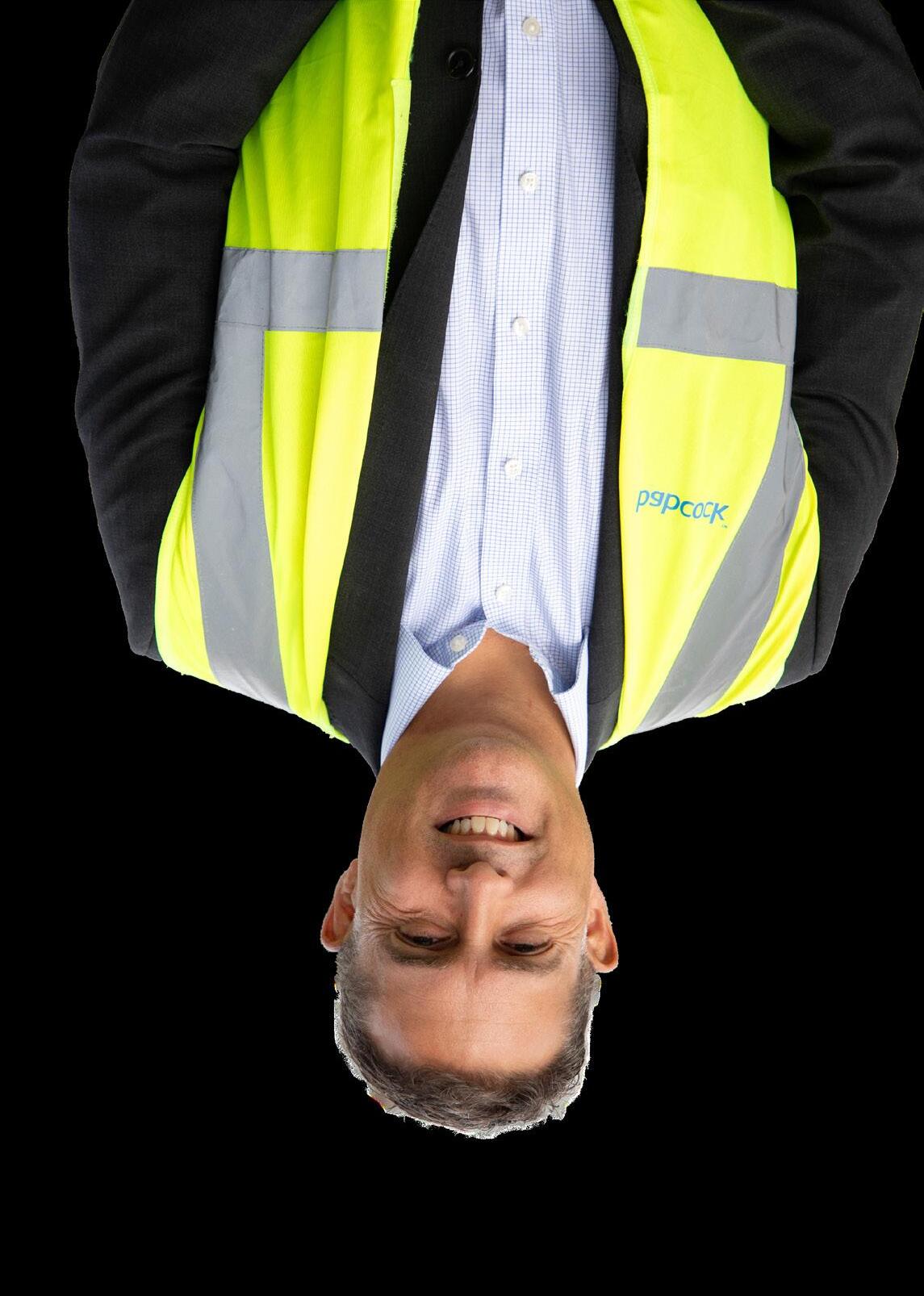
























Digital Earth Africa secures additional funding from The Leona M. and Harry B. Helmsley Charitable Trust to broaden the scale and enhance the outcomes of its endeavours.


it was widely regarded as an innovative and revolutionary way for Africans to access and leverage Earth observation data to enhance decision-making around critical environmental and socioeconomic challenges.
With support from trailblazing funders including The Leona M. and Harry B. Helmsley Charitable Trust, the Australian Government and Amazon Web Services, DE Africa has exceeded expectations, making good on its mission to support real-world impact and positive change across the length and breadth of Africa.
Now, as DE Africa moves into its next phase, it is crucial that the momentum is ramped up. The Helmsley Charitable Trust has recently committed an extension

of funding to contribute directly to further embedding the programme throughout Africa and ensuring longterm sustainment.
Walter Panzirer, a Trustee of the Helmsley Charitable Trust, says that a strong point of interest in DE Africa is the growing potential to transform data into evidence-based, actionable insights for Africa.
“Key for us is supporting programmes that drive action and impact, in which insight informs policy, and policy translates into tangible, positive
change for communities. DE Africa leverages technology and data for sustainable development, sustained livelihoods, and resilient communities,” says Walter. “We are committed to working with DE Africa to achieve our shared goal of meaningful progress across the continent.”
Dr. Lisa-Maria Rebelo, Acting Managing Director of DE Africa, says, “The extended support from the Helmsley Charitable Trust not only enables DE Africa to increase our impetus, but also provides us with a crucial opportunity to explore long-

term sustainment strategies. This commitment further underscores DE Africa’s role as a vital pan-African resource for policymakers, scientists, civil society and the private sector.”
To solidify the role that DE Africa plays in the continent requires a multi-pronged approach. Incountry engagement with high-level stakeholders at the national level is complemented by outreach to regional, interregional and global organisations to drive consistent
uptake of DE Africa that ultimately informs policy and decision making. In parallel, broad-based communitylevel engagement takes place with individuals, local community groups, on-the-ground organisations and private sector players who are actively participating in managing their natural resources while safeguarding livelihoods and economic means.
With just under 30,000 users of DE Africa’s visualisation interface/platform and 7,500 developers working in the virtualised sandbox environment, as well as almost 5,000 users registered
for DE Africa’s online learning programme, user numbers continue to swell.
Almost 100 government departments and major regional, interregional and global institutions have adopted, or facilitated adoption, of the DE Africa tools and services. This includes specific engagements with more than 50 governmental and associated departments across Africa including (but not limited to) the Ministry of Water Resources and Irrigation in Egypt; National Statistics Department and Ministry of Agriculture in Tunisia; Somali National Bureau of Statistics; Ministry of Water in Benin; Ministry of the Interior in Djibouti; Kenya Space Agency; Rwanda Space Agency; Agence Gabonaise d'Études et d'Observations Spatiales (referring to the Gabonese Agency for Space Studies and Observations); Ghana Space Science and Technology Institute; Ministry of Mines and Strategic Resources in Madagascar; Geological Institute for Comoros; Ministry of Agriculture in Botswana; and the Western Cape Department of Water and Sanitation in South Africa.
Additionally, DE Africa has worked with regional and global organisations such as the African Union Commission; UN Economic Commission for Africa (UNECA);


“Today, DE Africa hosts more than five petabytes of data stored in Amazon Web Services Africa region (Cape Town), ensuring a secure and highperforming service”
UN Statistics Department; the United Nations Committee of Experts on Global Geospatial Information Management (UNGGIM); United Nations Office for Outer Space Affairs (UNOOSA); and the Organization for Economic Co-operation and Development (OECD).
For example, in Ghana, multidisciplinary researchers working with Ghana’s Space Science and Technology Institute have, through DE Africa’s satellite-based shoreline mapping capabilities, revealed critical insights into the dynamics of coastal erosion in the Keta Lagoon and Cape Coast city. Coastal erosion has triggered serious health concerns here, with saltwater intrusion affecting the quality of groundwater, leading to sanitation and hygiene issues
affecting surrounding settlements. These effects bear a very real cost for those communities living on the coastline and around the lagoon, where they must balance the hard choice of upheaval or displacement against potential ill health, dwindling livelihoods and incessant food insecurity.
The study was able to successfully identify high-risk erosion zones and evaluate the impact of existing sea defence projects, providing valuable data to support future interventions. These findings will contribute to the development of a near real-time coastal erosion monitoring system, which will serve as a crucial tool for government agencies such as the National Disaster Management Organisation, Fisheries Commission, the Ministries of Environment, Science, Technology, and Innovation, as well as Works and Housing.
Another compelling case has been a study in Kogi State, Nigeria, to enhance preparedness against disaster. Lying at the confluence of the Niger and Benue Rivers, this geographical location, coupled with the seasonal release of water from the Lagdo Dam in Cameroon, makes Kogi highly susceptible to severe flooding. With the frequency of floods increasing over the years, including major events in 1994, 2004, 2012, 2020, and again in October 2024 – which saw the displacement of thousands of people – flood management has become a critical concern for the state.
With traditional methods having proven inadequate in managing flood risks, researchers recently developed GIS-based hydrological models –validated through DE Africa’s data – to identify flood risk areas. Key factors such as elevation, proximity to water bodies, land cover, and population density were considered. Actionable


information was developed to guide evacuation planning: evacuation maps highlight accessible routes, safe zones and vulnerable areas where roads may be impassable. These maps, leveraging DE Africa data, offer the potential to ensure timely evacuations, reducing the potential loss of life and property.
The Australian Government, together with African partners, led the inception and establishment phase of DE Africa by using innovative technology created by Digital Earth Australia for the African continent.
DE Africa has built a robust operational infrastructure, providing timely and reliable Earth observation data to a diverse range of users. The programme leverages the Open Data Cube (ODC) technology. The ODC, a not-for-profit open-source project and community, was created and is facilitated by the
Committee on Earth Observation Satellites (CEOS), with the Australian Geoscience Data Cube (AGDC) as its initial implementation. Geoscience Australia remains a contributor to the science and technology for the program. DE Africa simplifies the management and analysis of vast amounts of satellite imagery. Its platform offers pre-processed, analysis-ready data that maps the continent in unprecedented detail, including more than three decades of historical data to near real-time updates.
Today, DE Africa hosts more than five petabytes of data stored in Amazon Web Services Africa region (Cape Town), ensuring a secure and highperforming service.
For more information about Digital Earth Africa and its initiatives, please visit www.digitalearthafrica.org.
Source: Digital Earth Africa
Stay















Innovation Magazine is a specialist technology platform with over 166,700+ readers.
Our community consists of C, V and D level executives from a wide range of industries. A unique blend of thought leadership interviews and features that cover digital transformation, cloud & cyber, enterprise IT, artificial intelligence, machine learning and sustainability.




Demand



Webinars - Hosting & Promotion



Team up with Innovation Magazine and build media programs that deliver.
Find out more


How AI infrastructure startup Ori is building the AI backbone for the future.
mbitious companies recognise the truly transformative power of AI.
But the full potential of AI will only be unlocked by teams that can seamlessly access and deploy the infrastructure they need to train, serve and scale models with full flexibility.
Our Startup of the Month, Ori, is at the forefront of providing end-to-end AI infrastructure – combining powerful GPU compute with a flexible software layer that optimises resources.
Founded in 2019, the UK-based startup provides companies with pay-asyou-go cloud-based access to high performance compute for AI model training, by partnering with data centres across Europe.

Last year, Ori announced it would become the first company to deploy Nvidia’s new H200 chips in the UK as the London tech firm seeks to ramp up its capacity to cater to the rapidly-growing needs of AI businesses.
Then, in February 2025, Ori raised $140m to scale its compute-as-aservice business as governments across Europe ramped up spending on the rails that power artificial intelligence.
With Ori, teams can explore, build, and scale AI innovations effortlessly, transforming how software and hardware work together to drive the next wave of AI breakthroughs.
Learn more about Ori here.


“With Ori, teams can explore, build, and scale AI innovations effortlessly”



